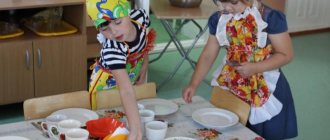Consultations for educators “How to properly organize children’s nutrition in preschool settings”
Consultations for educators
“How to properly organize children’s nutrition in preschool settings”
An essential component of the daily routine. The entire process associated with feeding children is of great educational importance. Children are taught the important hygiene skills of washing their hands before eating, rinsing their mouths after eating, and using cutlery and napkins; They are taught to chew food thoroughly, eat carefully and sit correctly at the table.
When carrying out the feeding process, everything that is included in the concept of “nutritional aesthetics” is of great importance.
During their stay in a preschool institution, the child learns to behave properly at the table, use utensils (spoon, knife, fork), and acquires certain food culture skills.
Issues of nutritional aesthetics should be given attention, starting with groups of young children. The earlier a child develops correct eating habits, the more firmly they will become established and become a habit.
It is important that your baby develops a positive attitude towards eating so that he is not irritated or tired by the time he feeds. To do this, educators must take care to create a calm environment in the group. Before eating, you should avoid noisy games and strong impressions, which can inhibit the production of digestive juices in children and suppress the food reflex.
20-30 minutes before the next meal, children are returned from a walk or activities and games are stopped. This time is used to create a certain mood in children that is conducive to eating.
Before eating, children put their clothes in order, wash their hands thoroughly, and the attendants take whatever part they can in setting the table. Each child has a permanent place at the table.
During feeding, it is important to create a good mood in children. To do this, the preschool institution must have beautiful, comfortable, stable dishes and cutlery that are appropriate in size for the age of the children. The tables are covered with tablecloths or napkins, and vases of flowers are placed. The dishes are served beautifully presented, not very hot, but not cold either. To decorate dishes, it is advisable to use fresh herbs, brightly colored vegetables, and fruits.
During the feeding process, the teacher should not rush the children or distract them with extraneous conversations or comments. During feeding, children are told about the pleasant appearance, taste, smell of food, its usefulness, and they try to focus each child’s attention on food. It is necessary to monitor the behavior of children at the table, maintain cleanliness and tidiness, teach them to chew food well, not swallow it in large pieces, and eat everything that is offered.
Compliance by children with hygiene requirements is one of the responsibilities of the teacher during the feeding process. This is especially important in groups of young children, when children are actively developing and consolidating skills and habits. Young children are taught to sit quietly at the table, skillfully use a napkin, chew with their mouth closed, and not talk while eating. Children learn to use cutlery: from 1.5 to 2 years old they eat with a spoon on their own, from 3 years old they use a fork. In preschool groups, children are given a full cutlery set (knives should not be sharp). Children in the senior and pre-school groups should be able to use a knife and fork correctly, holding it in both their right and left hands.
After finishing the meal, the children carefully blot their mouths with a napkin and wipe their hands, thank them for the food and leave the table. Children should not be allowed to leave the table with a piece of bread or other food, including fruits or berries, cookies or candy.
When feeding children, especially young children, it is necessary to follow the sequence of processes and not force preschoolers to sit at the table for a long time waiting for the meal to start or a change of dishes. The next dish is served immediately after the previous one is eaten. Children who finish eating before others can be allowed to leave the table and engage in quiet play.
Educators pay great attention to children with decreased appetite. When feeding such children, it is especially important to follow the recommended age-specific portion sizes and take into account individual tastes and habits. Too much food can only discourage the child from eating and lead to an even greater decrease in appetite.
You should not force feed your baby, entertain him while eating with toys, pictures, tell fairy tales, etc. When a child's attention is distracted, the production of digestive juices is inhibited and the food reflex is suppressed.
Children with poor appetite can be offered small amounts of water or fruit juice at mealtimes to help them wash down a solid meal. In some cases, you can offer your child a second course first so that he can eat the more nutritious part of the meal before he loses interest in eating.
When feeding a child with poor appetite, his tastes and habits are taken into account: you should try to give your favorite dish, ordering it from the kitchen if necessary. Such a child is patiently introduced to other healthy foods. Sometimes it is allowed to mix the most nutritious dish the child needs (meat, egg, cottage cheese) with fruit puree, juice or another product that the child likes. Older children are explained in an accessible form the need to first eat this or that dish or part of it, and the child is praised if he has eaten everything without a trace.
For this purpose, the following rules must be observed:
- everything necessary for organizing meals (arranging tables in the prescribed order, serving them correctly for children of each age, etc.) should be prepared by the time the children begin to wash their hands.
- wash and sit down at the table gradually, starting with younger children and those who eat slowly.
- do not detain children after finishing the meal.
- Prepare food for younger children in advance (cut meat, pancakes, etc.).
- the procedure for serving children, the requirements of the teacher and junior teacher must be uniform and constant.
Thus, systematic, purposeful management of children’s nutrition makes it possible to train them in many good deeds, instill stable hygienic skills, expand their everyday orientation, and solve the problems of moral education.

